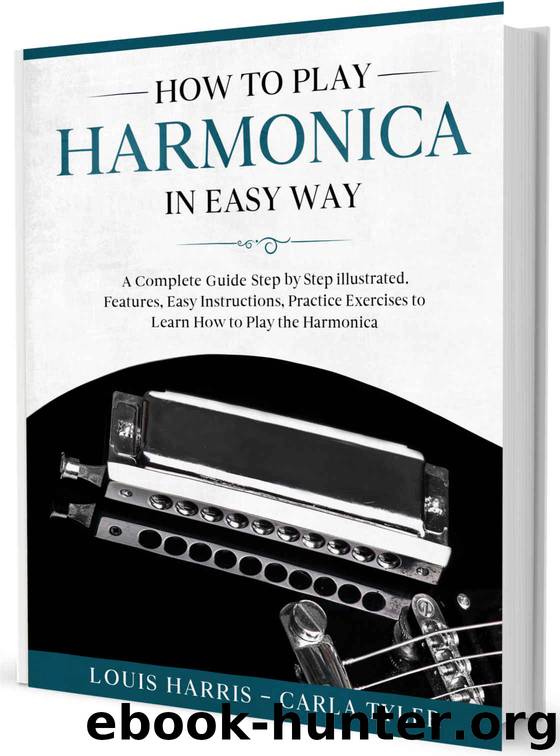How to Play Harmonica in Easy Way: A Complete Guide illustrated Step by Step, to Learn how to Play Harmonica in Easy way. Basics, Features, Easy Instructions by Harris Louis & Tyler Carla

Author:Harris, Louis & Tyler, Carla [Harris, Louis]
Language: eng
Format: epub
Published: 2020-03-23T16:00:00+00:00
F#
Bb
Bb
C
D
F
F
A
Bb
C
D
Eb
F
G
Bb
A
D
C
F
Eb
Bb
G
B
B
C#
D#
F#
F#
A#
B
C#
D#
E
F#
G#
B
A#
D#
C#
F#
E
B
G#
Music Notation with Tablature
Like guitars, harmonicas can be played by following sheet music, which decreases the notes on a sheet of music down to a simple-to-follow arrangement of holes and breath designs. Sheet music is valuable for bigger chromatic harmonicas too. However, it varies to some degree from diatonic sheet music and is less normal.
Breathing is set apart by bolts. An up bolt demonstrates a breath out; a down bolt shows a breath in.
Most holes on a diatonic harmonica produce two "neighbour" notes on a given scale; in this way playing C and afterwards, D on a similar scale is cultivated by blowing into the proper gap and afterwards attracting from a similar opening.
Holes are set apart with a number, beginning from the most minimal (left-hand) tone and moving upward. Subsequently, the most minimal two notes are (up) 1 and (down) 1. On a 10-gap harp, the most elevated note would be (down) 10.
A few notes on a normal 10-opening harmonica cover, eminently (down) 2 and (up) 3. This is important to permit an appropriate range for playing scales.
More propelled techniques are set apart with cuts or another little imprint. Corner to corner cuts through the bolts demonstrate that note bending (covered later) is required to get the best possible tone. Chevrons or slices on chromatic sheet music can likewise demonstrate whether or not to hold the catch in.
There is definitely not an institutionalized arrangement of sheet music that is utilized by all harmonica players. Be that as it may, when you rehearse and get comfortable perusing one sort, most other types will sound good to you rapidly.
Sheet music is a music notation method for a particular instrument. There are numerous sheet music frameworks for the harmonica. Right now will utilize the accompanying sign shows:
A positive number (p.e. 5 or +5) implies you need to blow on that opening.
A negative number (p.e. - 5) implies you need to draw on that gap.
A number that is bigger than 10 is a chord. For instance, 12 is the chord of blowing in holes 1 and 2 at the same time, - 567 is a draw of holes 5, 6 and 7, etc. This method is for 10-opening diatonic harmonicas, so this notation isn't an issue. For harmonicas (generally chromatic) that have more than 10 holes, other notation frameworks are utilized.
A number with a statement (p.e. 5') implies you need to play on that gap considerably bending the note (you will get familiar with this procedure later on).
A number with a twofold statement (p.e. 5") implies you need to play on that gap by full-bending the note (you will gain proficiency with this procedure later on).
A number with a triple statement (p.e. 5''') implies you need to play on that gap by over-bending the note (you will gain proficiency with this procedure later on).
Download
This site does not store any files on its server. We only index and link to content provided by other sites. Please contact the content providers to delete copyright contents if any and email us, we'll remove relevant links or contents immediately.
The Goal (Off-Campus #4) by Elle Kennedy(13207)
Kathy Andrews Collection by Kathy Andrews(11340)
Diary of a Player by Brad Paisley(7270)
What Does This Button Do? by Bruce Dickinson(5936)
Assassin’s Fate by Robin Hobb(5862)
Big Little Lies by Liane Moriarty(5521)
Altered Sensations by David Pantalony(4872)
Pale Blue Dot by Carl Sagan(4627)
Sticky Fingers by Joe Hagan(3916)
The Death of the Heart by Elizabeth Bowen(3342)
The Heroin Diaries by Nikki Sixx(3325)
Beneath These Shadows by Meghan March(3154)
Confessions of a Video Vixen by Karrine Steffans(3104)
The Help by Kathryn Stockett(3023)
How Music Works by David Byrne(2968)
Jam by Jam (epub)(2881)
Harry Potter 4 - Harry Potter and The Goblet of Fire by J.K.Rowling(2814)
Strange Fascination: David Bowie: The Definitive Story by David Buckley(2702)
Petty: The Biography by Warren Zanes(2575)
